Bats of BC
There are 16 species of bats that make British Columbia their home, 10 are found in the south coast. They all belong to microbat group with their small bodies, large ears and all use ecolocation. Here is a short description of the bats you may see in your area.
(Information and pictures are from the South Coast Bat Action Team or www.scbat.org)

Big Brown Bat
- relatively large bat, 98-131 mm in length and weighs 12-22 g
- broad head and nose, long fur varies from pale to dark brown, ears and flight membranes are black
- likes buildings, often called "barn bat"
- colony can number up to 700 but commonly number up to 50 here in BC
- emerge at dusk to feed over water, forest canopies, along road, clearings, urban areas
- range from Vancouver Island, up coast to Bella Coola River Valley and into the interior.
California Myotis
- one of smallest bat species in BC
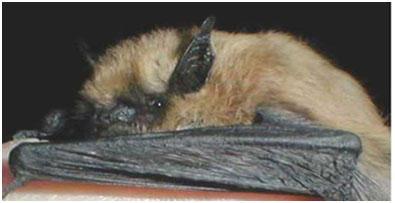
- 65-95 mm in length, weights 3.3-5.4 g
- dull fur is rusty-blackish brown. Ears, wings and tail membrane black. Ears are long
- uses rock crevices, tree cavities, spaces under bark of trees, buildings, bridges for summer day roost.
- will use almost any natural/ man-made structure for night roost.
- males live separately from females in summer
- hunts mainly over lakes as well as poplar grove canopies.
- range from islands of BC (including Haida Gwaii), up coast to Bella Coola River Valley, in interior north to Wells Gray Park and east to Kootenay Nat. Park.
- inhabits grasslands, coastal forests and mountain forests.
Hoary Bat
- largest bat in BC, total length 125-144 mm, weighs 20-38 g
- the soft fur is mix dark-brown and grey with white-tipped hairs
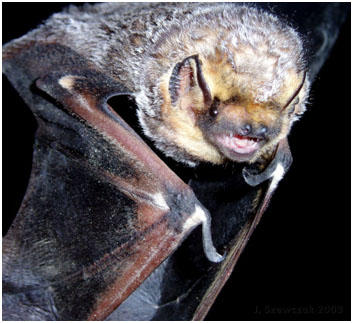
- small patches of yellow/white on shoulders, wrists, throat, ears and underside wing membranes. Wing membranes are dark brown with paler areas on forearm and fingers.
- ears round and short
- favourite roosts are branches of trees, called "tree bat"
- rarely uses caves or buildings
- during summer males are solitary, females stay with young. Due to threats from exposure to young, the family group stays together in the same roost for more than a month
- forage throughout night, extremely attracted to light
- once established feeding area, will defend and chase away other bats
- found Vancouver Island, up coast to Garibaldi Park, in interior north to Williams Lake
- habitat variety of forests and grasslands
Keen's Long-eared Myotis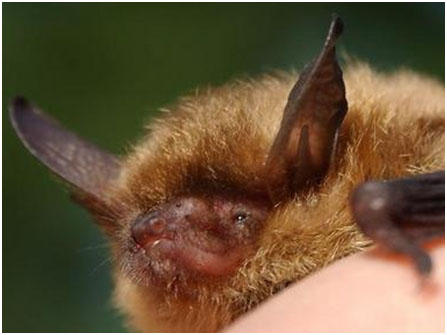
- medium sized bat 63-94 mm in length, 4-6 g
- dark glossy fur, pale undersides, dark spots behind shoulder. Long ears extend beyond nose. Ears and wing membranes dark brown
- little known about this bat
- roosts in tree cavities, rock crevices, small caves
- only North American bat restricted to Pacific Coast
- found on Vancouver Island, Haidi Gwaii, up coast to Stikine River
Little Brown Bat
- medium sized bat, 70-108 mm in length, 6-10 g
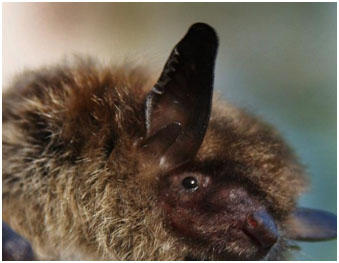
- variable fur colour, yellow/olive to blackish on back and light brown to tan on belly. Ears and wing membranes dark brown. Blunt nose
- summer roosts buildings, man-made structures, tree cavities, rock crevices, caves, under the bark of trees
- sexes live separately in summer
- maternity colonies contain hundreds to thousands of bats
- hibernate in caves/ abandoned mines, do not use buildings. May hibernate alone or in groups
- range throughout entire mainland, Vancouver Island, Haida Gwaii
- feeds on variety of insects at dusk
- habitats arid grasslands, coastal and interior forests, northern boreal forests

Long-legged Myotis
- large bat , 83-105mm in length, 5-10 g
- long fur ranges in colour from reddish brown to nearly black. Has short rounded ears
- little known about this bat
- for summer and maternity roosts uses buildings, rock cliff crevices, under bark of trees
- night roost uses caves, abandoned mines
- active during whole night even when cold, more tolerate of cold temperatures compared to other bats
- range Vancouver Island, coastal areas near Vancouver, interior to northern BC, east to Revelstoke
- habitat arid rangeland of interior, mountain and coastal forests
Silver-haired Bat
- 90-117mm in length, 6-12 g
- distinctive lightly frosted appearance, dark brown/black fur with scattered silver tipped hairs. The frosted hairs give it a white belly. Short, round ears, ear and wing membranes black
- tree bat, trees important for hibernation sites
- summer roosting occurs under bark of trees, crevices of trees, abandoned bird nests, woodpecker holes
- roost alone or in small groups.
- found in BC all year
- hunts at dusk in clearing, around tree tops, over water
- found throughout coast BC, interior north to Peace River
- habitat forests, grasslands
Townsend's Big-eared Bat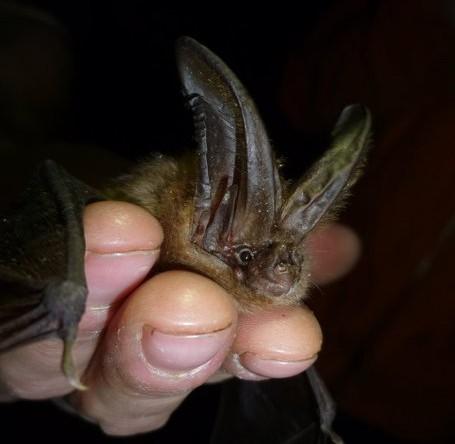
- medium bat with enormous ears about 1/2 of body length. Also has two prominent glandular swellings on nose
- 83-113 mm in length, 6-13.5 g
- long black fur is pale brown to blackish grey
- uses caves, mines, buildings as summer day and night roosts
- maternity colonies number from dozen to several hundred
- very sensitive to human intrusion, will abandon summer roost if disturbed
- maternity colonies break up in August, individuals migrate to caves, mines for hibernation. One of few bats constantly hibernates in BC
- range Vancouver Island, Gulf Islands, Vancouver, interior north to Williams Lake
- habitat coastal forests, arid grasslands
Western Long-eared Myotis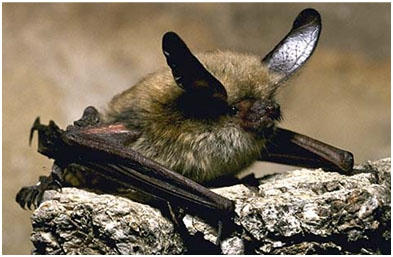
- large bat, 74-103 mm in length, 4.2-8.6 g
- colour ranges from yellowish brown to nearly black, blackish-brown shoulder patches, long ears and flight membranes black
- summer roost commonly buildings, under the bark of trees
- maternity colonies from 5-30 individuals with some males
- no winter roosts in province, migratory bat
- will feed after dark upon wide range of insects caught both in the air and off vegetation. Prey is mainly moths, beetles, flies and spiders
- range entire coastline to Bella Coola, Vancouver Island, interior north to Prince George
- wide range of habitats
Yuma Myotis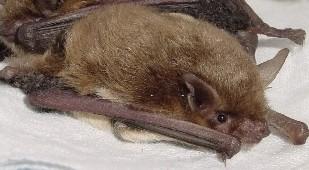
- medium sized bat, 60-100 mm in length, 4-9 g
- fur pale brown to nearly black, pale belly, ears and wing membranes dark brown
- summer day roosts are buildings, man-made structures close to water
- maternity colonies can be very large numbering into thousands
- males roost separately from females, either alone or in small groups
- hunts over lakes, rivers, streams feeding on aquatic insects. Night roosts are bridges, house porches
- range Vancouver Island, mainland north to Kimsquit, interior north to Williams Lake, east to Nelson
- habitat coastal forests, interior forests, arid grasslands

